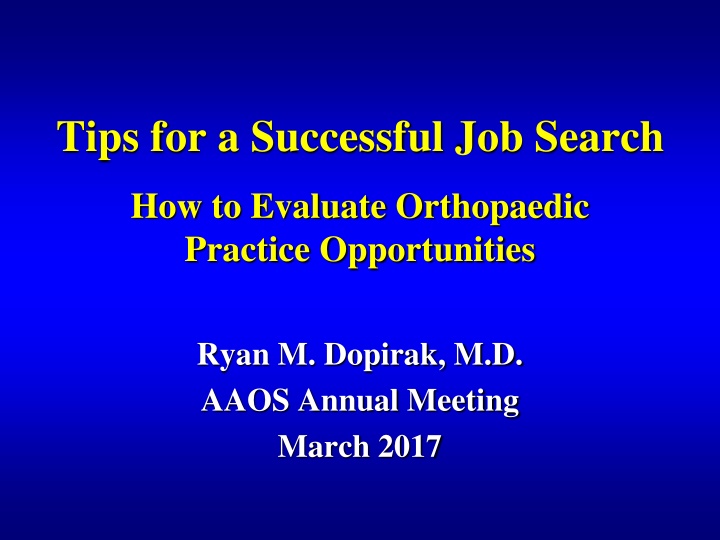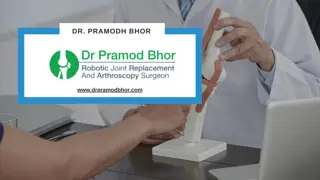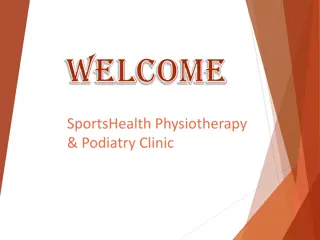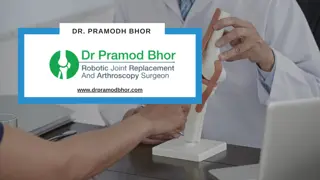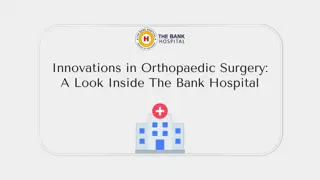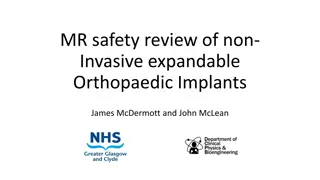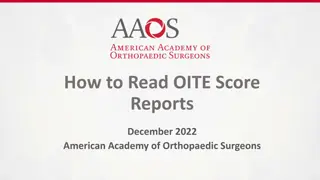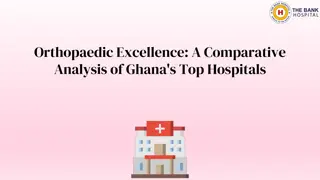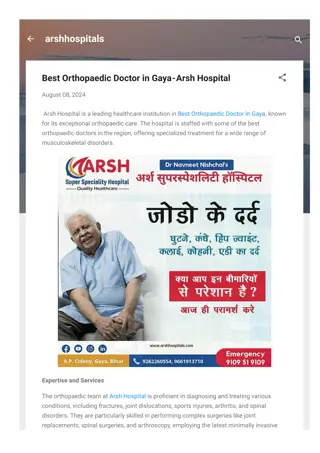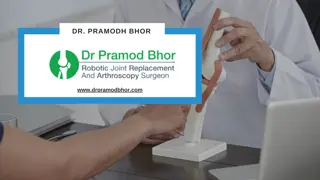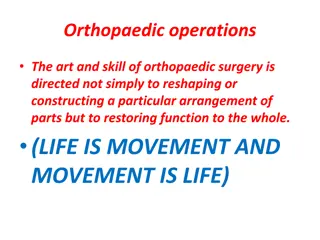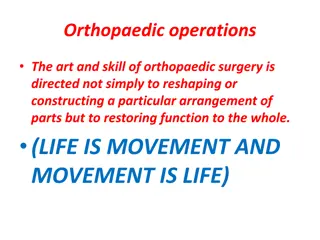Tips for Evaluating Orthopaedic Practice Opportunities
Learn key considerations for evaluating orthopaedic practice opportunities to ensure a successful job search. Understand why practices are recruiting, assess your fit within the group, and ask critical questions before signing a contract to avoid potential pitfalls. Make informed decisions to enhance your career satisfaction and well-being.
Download Presentation

Please find below an Image/Link to download the presentation.
The content on the website is provided AS IS for your information and personal use only. It may not be sold, licensed, or shared on other websites without obtaining consent from the author.If you encounter any issues during the download, it is possible that the publisher has removed the file from their server.
You are allowed to download the files provided on this website for personal or commercial use, subject to the condition that they are used lawfully. All files are the property of their respective owners.
The content on the website is provided AS IS for your information and personal use only. It may not be sold, licensed, or shared on other websites without obtaining consent from the author.
E N D
Presentation Transcript
Tips for a Successful Job Search How to Evaluate Orthopaedic Practice Opportunities Ryan M. Dopirak, M.D. AAOS Annual Meeting March 2017
Disclosures I have no potential conflicts with this presentation
Introduction The average orthopaedist will make 2-3 practice changes over the course of their career Up to 50% of orthopaedists will make a change within the first 2 years
Introduction Changing jobs can result in a great deal of stress and significant financial losses Lost income Moving expenses Malpractice tails Repayment of signing bonuses
Purpose Teach residents/fellows how to critically evaluate orthopaedic practice opportunities Learn more about what you are actually signing up for (before you sign a contract) Decrease likelihood that you end up unhappy Nobody cares about your well-being or your contract more than you do!!!
Format List of simple questions to ask each potential employer
Why are they recruiting a new orthopaedic surgeon?
Why are they recruiting a new orthopaedic surgeon? They must demonstrate they have a need for your services Impending retirement of partner Desire to add new subspecialty area to practice Need to accommodate increasing patient volumes (population growth)
Why are they recruiting a new orthopaedic surgeon? There are numerous groups who are looking to hire for reasons that benefit the group more than the candidate Trying to decompress call schedule Trying to dilute overhead Your buy-in will be a buy-out for a senior partner Attempt to increase group size to compete against other groups in their market ( nuclear arms race )
What is the practice setting? Single Specialty Orthopaedic Group Multispecialty Group Academic / University-Based Hospital Employment
Single Specialty Group (SSG) Advantages Disadvantages Autonomy Ancillary opportunities Usually eat what you kill The classic gold standard Referrals not guaranteed Modest guarantee May require buy-in
Multispecialty Group (MSG) Disadvantages Advantages Average overhead is higher vs SSG Specialists sometimes subsidize PCP s Automatic referral base Competitive initial compensation package
Academic Setting Advantages Disadvantages Prestige High volume of referrals Opportunity to work with residents/fellows Lower income vs SSG Level I Trauma Call
Hospital Employment Advantages Disadvantages Competitive initial compensation package Guaranteed referrals Less administrative responsibilities, able to focus on your practice Limited autonomy Less opportunity for ancillaries vs SSG
Hospital Employment Hospital-employed physician model is becoming more common MHA 2015 Review of Physician Recruiting Incentives 2004- 11% of searches were hospital-employed opportunities 2014- 64% of searches were hospital-employed opportunities 2016- 49% of searches were hospital-employed opportunities www.merritthawkins.com AAOS OPUS Percent of orthopaedists who are hospital-employed 2012: 9% 2014: 15%
Hospital Employment Physicians are looking for stability Less risk / uncertainty with hospital employment Competitive income / salary guarantee Increased leverage with insurers results in better contracts Built in primary care referral base = immediate volume Hospital subsidizes physicians Less capital investment- EMR, facilities, marketing Some physicians are looking for a golden parachute Who else is going to buy the 30 year old outdated office building when the older partners retire?
Hospital Employment Hospitals want to align themselves with physicians Ability to control referrals to specialists and ancillary services Enhanced leverage when negotiating contracts May result in higher reimbursement rates with major insurers Greater success in selling narrow network plans to employers Hospitals are preparing for healthcare reform ACO s Bundled payments Pay for performance Implementing changes will be smoother if physician alignment exists
Hospital Employment Hospital employment of orthopaedic surgeons How can hospitals offer such high starting salaries? Annual revenue produced by an orthopaedic surgeon $2,750,000 MHA 2016 Physician Revenue Survey Revenue generated from referrals to MRI, PT, surgery should offset any losses from income guarantee
Hospital Employment What are the potential risks of hospital employment? Loss of autonomy- you may potentially be taking orders from hospital administrators Very limited opportunity to invest in ancillaries due to regulations pertaining to employed physicians The network or physician division comes first ahead of any specialty group, including orthopaedics
Hospital Employment What are the potential risks of hospital employment? Highly compensated specialists- there is always some risk that you will be asked to subsidize lower producing specialties Compensation philosophy may potentially change if there is a change in hospital leadership- the average tenure of a hospital CEO is approximately 5 years Although your initial contract may be favorable, this does not guarantee that renewal contracts will be identical to the first- if your production is not sufficient to cover your salary and expenses, you may be asked to accept a salary reduction
Which Practice Setting is Best? These are my personal opinions only! Small independent orthopaedic groups are at risk Large networks are getting larger and significant pressures exist to keep referrals in-network; where will your patients come from? Pressure from insurance companies to contain costs may lead to lower reimbursement to small groups due to lack of negotiating power Ever-increasing regulatory burden from the government favors larger physician networks (EMR, outcomes reporting, etc) The trend is towards increasing size Large single specialty groups Large independent multispecialty groups Large hospital-employed physician networks
Current Orthopaedic Workforce AAOS OPUS 2014 35% private orthopaedic group (SSG) 16% academic practice 13%- salary from academic institution 3%- salary from private practice 15% solo orthopaedic practice 15% hospital-employed 10% private multispecialty group 2% military
What is the surgeon density? AAOS OPUS 2014 8.5 surgeons per 100,000 population 1 surgeon per 11,765 population Also gives surgeon density by state Highest density states: WY, MT, NH, VT, SD Lowest density states: MI, WV, AR, TX, MS
What is the surgeon density? AAOS OPUS 2014 Use these statistics to gauge surgeon saturation in the market you are considering, BUT Don t write off a highly saturated market if you bring a new skill or unique subspecialty training to the market Success isn t guaranteed in a low density market, as groups in neighboring communities may draw from your area
Will I be able to develop an elective practice in my subspecialty area?
Will I be able to develop an elective practice in my subspecialty area? Over 90% of graduating residents pursue fellowship training* 93% of surgeons under age 40 consider themselves either a specialist or a generalist with a specialty interest (AAOS OPUS 2014) You need to decide how important specialization is to you *AAOS data, published February 2006
Will I be able to develop an elective practice in my subspecialty area? Do you want to develop a 100% subspecialty practice from the start? Are you willing to do a considerable amount of general orthopaedics / trauma in order to find a job in a competitive market?
Will I be able to develop an elective practice in my subspecialty area? Determine if the community can support a busy practice in your subspecialty area Look at the number of partners in the group with the same practice focus as you Also consider demographics of other groups in the market- they will be competing for the same patients
Will I be able to develop an elective practice in my subspecialty area? There should be a need for your specific area of specialization, so that you will have the opportunity to develop a busy elective practice Certain subspecialty areas are very competitive, especially in larger metropolitan areas Location vs. Professional Satisfaction!!!
Is there a restrictive covenant? A noncompete clause states that if you leave the group, you agree not to practice in a certain geographic area for a specified period of time You must determine if the terms of this provision are acceptable to you If you have community ties, you may wish to negotiate the terms of this clause
Is there a recapture clause? Some compensation packages include large income guarantees, signing bonuses, and loan repayment These are often contractually structured as forgivable loans - a percentage of this amount is forgiven each year over a set number of years
Is there a recapture clause? If you leave before fulfilling the contract, you may have to repay a portion of the money There is no such thing as a free lunch
What is the caseload of each partner over the past few years?
What is the caseload of each partner over the past few years? Income is directly related to surgical volume Compare volumes to national benchmarks AAOS OPUS 2014 Average FT orthopaedist - 32 cases/month MGMA Provides total encounters and RVU s
Has anyone left the group in the past 10 years and why?
Has anyone left the group in the past 10 years and why? The group will point out its positive attributes during the recruitment process A high rate of turnover may indicate underlying problems with the group and may be a red flag Contact the people who have left, as they may provide you with a different perspective on the group
ER Call How often is call and is it divided equitably? How many hospitals will you be covering? Is the hospital a trauma center How often is ortho called in for emergencies? Are you compensated for ER call?
ER Call Disadvantages Advantages Disruptive of elective practice and personal life Increased liability Poor payer mix- many patients uninsured or underinsured With increasing focus on specialization, surgeons less comfortable with trauma Increased caseload Increased income May be compensated for call
ER Call Trends in compensated call AAOS OPUS 2010 (no data in 2014 survey) 68% of orthopaedists take trauma call 40.4% of those taking call are compensated 2014 MGMA daily rate for compensated call* Mean / Median 25thpercentile 75thpercentile $1,016 / $1,000 $800 $1,050 *n=167; small sample size in most call surveys
ER Call Factors in determining daily rate for compensated call Trauma Center designation Volume of orthopaedic consults while on call Payor mix of ER patients Number of orthopods taking call (supply and demand) Call pay has to be at FMV rate
What is the income guarantee? Step 1: Clarify if it is a gross or net income guarantee Gross income: money is used to run your practice (overhead) and pay salary Net income: actual income or salary independent of overhead
What is the income guarantee? Step 2: Compare data to national surveys for starting salaries Merritt Hawkins 2016: $521,000 Average base salary or guaranteed income only, does not include production bonus or benefits MGMA 2013: $436,000 Median income for general ortho, 1-2 years in practice Not included in 2015 data set
What is the income guarantee? Step 3: Identify stipulations attached to guarantee What happens if collections don t cover salary, benefits, and overhead???
